- JP
- EN

The weather has been very warm lately. Flowers in the neighborhood are blooming happily.
We would like to inform you that the “Yuko Nakamura Japanese Painting Exhibition – Brilliance of the Four Seasons”, which was scheduled to open on May 7 (Thu.) at the Kintetsu Main Store in Abeno Harukas, has been canceled due to the spread of the new coronavirus infection.
Although the exhibition has been canceled, we took this opportunity to speak with . Yuko Nakamura!
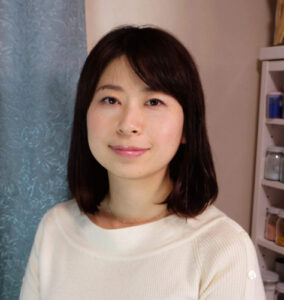
-What is the concept behind your work?
I use traditional flower-and-bird painting to depict the nature around us and the brightness of life of the small creatures that live there.
Have you been painting flower-and-bird paintings for a long time?
Since I was a child, I have always loved and been close to nature, plants, and living creatures (insects, birds, and other small creatures).
Perhaps that is why I have always liked and painted flower-and-bird paintings.
I would go to nearby parks and other places to find out what kinds of plants were there, catch insects and small fish and keep them, and even kept birds for a while.
I was the kind of kid who always carried a picture book with me.
There were not many big parks, botanical gardens, or nature around me, but I was very interested in nature that I could find around me, such as neighborhood parks and green trails.
In junior high and high school, I chose horticulture as a club activity and grew various vegetables and herbs (mainly edible ones rather than flowers, lol) in the school field, so I always had opportunities to be in contact with soil and nature.
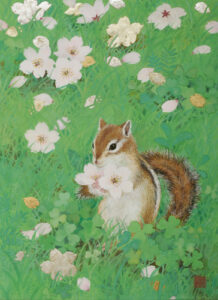
Sunshine” F4
-Have you ever tried other motifs?
I might be able to paint portraits or landscapes if they are familiar to me.
However, if I visit a place and paint it, or ask a model to paint it, I may not be familiar with it, and it may be difficult to put my feelings into it.
-When did you decide to become an artist?
I have loved to draw pictures ever since I can remember. When I was a high school student, I saw the paintings of Ito Jakuchu, Maruyama Okyo, and Hokusai at the Imperial Household Agency San-no-Maru Shozo-kan, and I knew I wanted to paint Japanese-style paintings.
I also like flower-and-bird paintings by Tanaka Isson, Komoda Seiki, Yamaguchi Kayo, and other Japanese painters of the Meiji and Taisho periods.
-What attracted you to Japanese painting?
You sympathized with the vivid colors of iwa-enogu (mineral pigments), and the idea of celebrating the changing seasons and small lives by painting familiar plants and creatures.
I was especially impressed by Jakuchu’s concept of depicting three Buddhist paintings in the center of the festschrift, with flora and fauna on either side to solemnize the world of the Buddha.
-Why did you go to Tokyo University of the Arts after graduating from Waseda University’s School of Letters I with a major in art history?
My family was against me becoming a painter, so I majored in art history at Waseda University, but I could not give up my dream of becoming a painter, so I entered the University of the Arts.
At Waseda, majors are not decided until the second year. Furthermore, even if you are chosen to major in art history, you will study art history extensively in the first year, including Western, Japanese, and Eastern art history.
Even if you are selected as an art history major, you will study a wide range of art history, including Western, Japanese, and Oriental art history in the first year, and then further specialize in Japanese art history in the third year.
-Did you start Japanese painting after you entered the University of the Arts?
Yes, I did.
I was exposed to Japanese painting only after I graduated from Waseda University and entered the University of the Arts after two years of study.
Also, there was no place to learn Japanese painting in high school club activities or cram schools.
There might have been private Japanese painting classes if I had looked for them, but that was almost 30 years ago, and there was no environment to research on the Internet at that time, and the era of living in a Japanese painter’s house and learning as an apprentice was already gone.
I think the only way to learn Japanese painting was to go to an art college.
Unlike oil painting, there were no good technique books, so it was difficult to learn how to paint on your own.
-You majored in conservation and restoration of cultural properties in graduate school, didn’t you?
At university, I did not have many opportunities to learn the traditional techniques and skills of Japanese painting.
I thought that if I entered the field of conservation and restoration of cultural properties, I could learn painting techniques by copying classical works, knowledge of materials used for Japanese painting, conservation methods, and knowledge of mounting for hanging scrolls and fusuma-e (sliding door panels).
Even now, this knowledge is very useful for my own work.
-Please tell us what you are most particular about in terms of techniques.
In order to express the brightness of life, I use gold leaf, Kirigane, which I learned during my graduate school days, mica, crystals, and other materials with strong luster in my works.
Although my works inevitably have more flat and decorative elements than realistic ones, I always hope to create “a world where realistic motifs such as plants and living creatures are well fused in my works.
-You learned Kirigane from the living national treasure Sayoko Ezato, didn’t you?
What do you find attractive about Kirigane?
Even if you draw thin lines with gold paint, you cannot draw sharp, strong, and uniformly thick lines like those of Kirigane.
Kirigane is very craft-like because it is made by cutting and pasting several layers of gold leaf with a bamboo blade.
By changing the thickness and shape of the cut, it is possible to draw delicate patterns that cannot be drawn with a brush, or to use it like a line drawing to draw shapes, and I find it attractive in that it allows new expressions other than just applying gold leaf.

(The foil is placed on a foil board made of deerskin and baked together, then cut into thin strips with a knife made of bamboo.
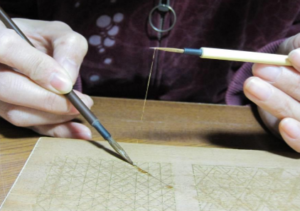
(The brush in the left hand is used to roll up one end of the foil that has been cut into thin threads, and the brush in the right hand is used to apply an adhesive mixture of glue and laver to the other end of the foil as it is being attached.
I also had the pleasure of meeting Dr. Ezato during my graduate school days.
It was a shame that our relationship was so short, as he passed away a few years after we met.
He generously shared his techniques with his students, saying that usually, one can only learn traditional craft techniques after many years of apprenticeship, but that this would lead to the techniques being buried, and that he wanted his students to compete with each other to refine their skills and pass them on to future generations.
It was wonderful that he was so enthusiastic about what he was doing.
She was a truly wonderful human being and a wonderful woman who cherished her family and was on good terms with her husband, Yasutoshi Ezato.
-Is there a certain pattern in your works?
Most of the cut gold patterns are added at the end after the coloring is completed, so I improvise based on the atmosphere of the picture and the image of the motif depicted.
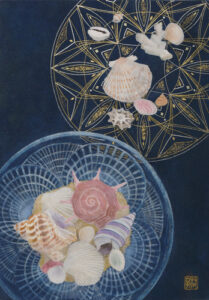
Natsu Sou” P3
-I heard that his works from his graduate school days are in the collection of the museum of Tokyo University of the Arts.
This is my master’s thesis work.
I copied the current state of a work from the Kamakura period called “Amida Sanson Raigo-zu.
It depicts Amida Nyorai in the Pure Land of Ultimate Bliss, flanked by Kannon Bosatsu and Seishi Bosatsu, the three Amida Sanson (Amida Sanson).
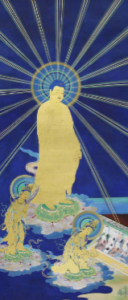
Assumed reproduction of the “Amida Sanzon Raigo-zu” (The Three Amitabha Spirits)
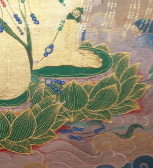
(Delicate cut gold is not only on the kesa-robe, but also on the lotus, waves, etc…!)
→Continue to No.2